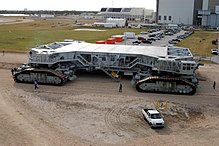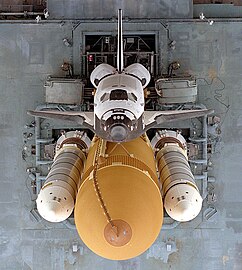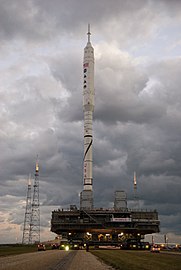Crawler transporter
The crawler-transporter , actually Missile Crawler Transporter Facilities are two crawlers vehicles for the transport of missiles and mobile launching pad (Engl. Mobile launcher platform or MLP) from the Vehicle Assembly Building (VAB) of the NASA along the Crawlerway to Launch Complex 39 . Originally developed for the transport of the Saturn IB and Saturn V during the Apollo , Skylab and Apollo-Soyuz programs , the crawlers were used for transporting the space shuttles from 1981 to 2011 after these missions were over .
The two vans were designed and manufactured by the Marion Power Shovel Company and Rockwell International . The total cost was US $ 14 million. Already during construction, the construction overtook other vehicles such as the excavator excavator Bagger 293 , the Big Muskie or The Captain in terms of dimensions and became the largest self-propelled structure in the world. The two crawlers were added to the National Register of Historic Places on January 21, 2000 .
technology
The crawler transporter weighs 2,721 tons and has eight crawler tracks , two on each corner. Each chain consists of 57 parts, each weighing 900 kg. The vehicle measures 40 by 35 m and the platform can be adjusted from 6.1 to 7.9 m above the ground. In order to keep the platform of the crawler straight with a deviation of a maximum of 10 arc minutes (0.16 degrees, at the top of the Saturn V that would be about 30 cm) while the crawler climbs a 5% gradient, the vehicle uses a laser guidance system and a leveling system. It is driven by a team of around thirty engineers and technicians.

Large rocket or shuttle to the Vehicle Assembly Building (VAB) already on the mobile launch table (Engl. Mobile launcher platform mounted or MLP). Each MLP weighs around 3,730 tons when unloaded and measures around 49 × 41 meters with a height of 7.6 meters. With some rockets, such as the Saturn V, the supply tower is also mounted on the MLP and driven to the launch pad together with the rocket on the crawler.
Since 2003, when the crawlers were overhauled, they have 16 motors, which are powered by four 1,000 kW generators. These are in turn powered by two 2,050 kW diesel engines. Six other motors are for rocket charging, lights and steering. 19,000 liters of diesel fit in the tank of the crawler, the consumption is 296 liters per kilometer.
The crawler is controlled from two control cabs located at either end of the vehicle and travels at a maximum speed of 1.6 km / h when loaded and 3.2 km / h when unloaded. The average travel time from the VAB along the crawlerway to Launch Complex 39 is approximately five hours.
The Kennedy Space Center has been using the same two crawlers, nicknamed "Hans" and "Franz", since it was first shipped in 1965. In their lifetime, the crawlers have driven more than 5,500 km, roughly the same distance as from Miami to Seattle.
Appearances in films and video games
The Crawler Transporters have appeared in a number of television series and films, such as:
- Season 3 of Dirty Jobs , where host Mike Rowe helps workers maintain a crawler truck and takes the vehicle for a short ride.
- Apollo 13 from 1995
- Transformers: Dark of the Moon from 2011
- Apollo 11 from 2019
Similar vehicles were used to transport and launch Jaegers in the 2013 film Pacific Rim .
In the video game add-on "Broken Steel" in Fallout 3 , the survivors of the US government have a mobile base that is built on a heavily converted crawler.
gallery
Ares IX missile on an MLP, including the crawler
Web links
Individual evidence
- ↑ a b National Park Service: Missile Crawler Transporter Facilities. In: NPGallery Digital Asset Management System. Retrieved May 24, 2019 .
- ^ NASA: Kennedy Prepares to Host Constellation. September 28, 2007, accessed June 7, 2009 .
- ↑ a b Matthew Peddie: NASA's Historic Giant Crawler Gets a Tune Up for Modern Times (Pics) . In: Transportation Nation . September 5, 2012. Archived from the original on May 9, 2013.
- ↑ American Society of Mechanical Engineers (Ed.): Mechanical Engineering . tape 99 , 1977, pp. 82 .
- ↑ a b c NASA: Crawler Transporter. April 21, 2003, accessed June 18, 2007 .
- ↑ KSC-05PD-1322 . In: NASA.gov . June 15, 2005. Archived from the original on January 9, 2008. Retrieved June 18, 2007.
- ↑ Countdown! NASA Launch Vehicles and Facilities . In: NASA.gov . October 1991. PMS 018-B. Archived from the original on January 9, 2008. Retrieved June 18, 2007.
- ↑ a b c Crawler Transporter Archived from the original on March 20, 2009. In: NASA (Ed.): Return to Flight Spotlight . No. 1, April 2004.
- ^ Todd Halvorson: Shuttle Safe Haven Opens at Kennedy Space Center . In: Space.com . August 13, 2000. Archived from the original on September 20, 2005.
- ↑ Jason Sands: NASA's Diesel-Powered Shuttle Movers. In: Diesel Power. May 2007, archived from the original on March 20, 2013 ; accessed in 2011 .
- ↑ The Complete Dirty Jobs Show Guide: 2007 . In: Discovery.com . Archived from the original on October 12, 2012.








